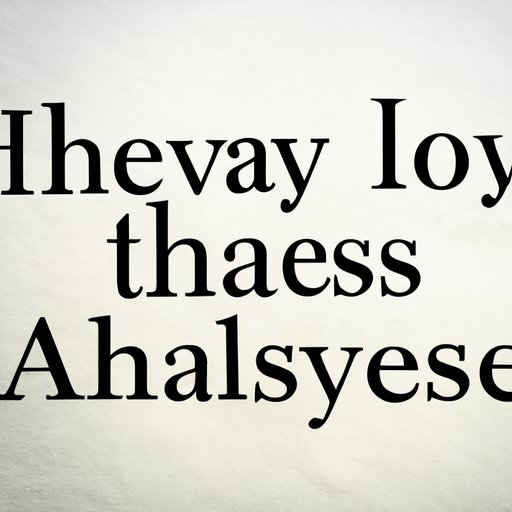
I. Introduction
Elizabeth Barrett Browning’s Sonnet 43, also known as “How Do I Love Thee,” is perhaps one of the most well-known love sonnets in the English language. Its popularity is due to the beautiful and evocative language used by Browning, as well as the timeless message of love and devotion that it conveys. In this article, we will provide a comprehensive analysis of the poem, breaking down its complexities and exploring the different elements that contribute to its impact. We will also delve deeper into the emotional and poetic aspects of the poem, as well as its societal relevance and enduring appeal.
II. Breaking Down the Complexities of “How Do I Love Thee”: A Comprehensive Analysis
The sonnet consists of fourteen lines, with a strict rhyme scheme of ABBA ABBA CDC DCD. Its meter is iambic pentameter, with ten syllables per line. The structure and form of the poem contribute to its overall impact, making it a tightly woven and powerful expression of love and devotion.
III. An In-Depth Look at Elizabeth Barrett Browning’s Sonnet 43: “How Do I Love Thee”
The sonnet is a declaration of love addressed to the speaker’s beloved. It begins with the question “How do I love thee? Let me count the ways,” and then goes on to list different methods and degrees of love. The overall message of the poem is one of deep and abiding love, expressed through the speaker’s devotion and gratitude towards their beloved.
The poem is full of beautiful and evocative metaphors and imagery, such as “I love thee to the depth and breadth and height my soul can reach,” and “I love thee with the breath, smiles, tears, of all my life! – and, if God choose, I shall but love thee better after death.” These images convey the depth and intensity of the speaker’s passion and emotion, making the poem an enduring expression of love that resonates with readers across different cultures and time periods.
IV. Decoding the Emotions in “How Do I Love Thee”: A Critical Analysis
The speaker of the poem expresses a range of emotions, including love, devotion, gratitude, and humility. These emotions are conveyed through language and imagery, making the poem a powerful expression of the human experience of love. The intensity of the poem’s emotional impact can be seen in its enduring popularity and universal appeal.
V. Exploring the Romanticism in Elizabeth Barrett Browning’s “How Do I Love Thee”: An Analysis
The Romantic literary movement emphasized the importance of emotions, individualism, and nature, among other traits. Elizabeth Barrett Browning’s “How Do I Love Thee” embodies these qualities, making it a timeless and enduring piece of literature. The poem’s focus on the individual experience of love, as well as its natural imagery, contribute to its Romanticism and enduring appeal.
VI. Appreciating the Beauty in “How Do I Love Thee”: A Poetic Analysis
One of the most remarkable aspects of “How Do I Love Thee” is its beautiful and evocative language. The use of metaphors and images, as well as sound devices like alliteration and assonance, contribute to the poem’s musicality and impact. The poem’s beauty and poetic sophistication have made it a favorite of readers and scholars alike.
VII. Interpreting the Linguistic Devices in Elizabeth Browning’s “How Do I Love Thee”
The poem features a number of linguistic devices, such as metaphor and imagery, which help convey its overall message. These devices contribute to the poem’s power and beauty, as well as its universal appeal.
VIII. The Universal Appeal of “How Do I Love Thee”: A Societal Analysis
The poem’s universal appeal can be attributed to its timeless message of love and devotion, which resonates with readers across various cultures, genders, and age groups. The poem speaks to the human experience of love, making it an enduring expression of the power of human emotion.
IX. Conclusion
In conclusion, Elizabeth Barrett Browning’s “How Do I Love Thee” is a powerful and enduring expression of love and devotion. Its beauty and poetic sophistication, combined with its timeless message and universal appeal, have made it one of the most beloved love sonnets in the English language. Readers of all ages and backgrounds can benefit from its message of love and the power of human emotion.





